Iran is actively promoting sustainable construction and energy-efficient architecture through its top green buildings initiatives. The country is making efforts to improve energy efficiency in buildings to address its high energy consumption and carbon dioxide emissions. With Iran ranking among the top 10 emitters of carbon dioxide and spending a significant portion of its GDP on energy subsidies, there is a growing focus on implementing environmentally friendly practices in construction.
- Iran is actively working towards improving energy efficiency in buildings to address high energy consumption and carbon dioxide emissions.
- The country ranks among the top 10 emitters of carbon dioxide and aims to reduce its environmental impact.
- Pilot projects targeting government buildings have resulted in significant savings in electricity and natural gas consumption.
- Iran is experiencing a boom in contemporary architecture, integrating modern design principles with sustainable construction practices.
- Architects in Iran are also incorporating traditional elements of vernacular architecture to respect the country’s history and culture.
Green Building Design in Iran
Green building design plays a crucial role in Iran’s efforts to promote eco-friendly construction practices and sustainable development. The country’s commitment to creating environmentally friendly buildings is evident in its green building initiatives and the incorporation of sustainable elements in architectural designs.
Iran’s focus on green building design is driven by the need to address high energy consumption and reduce carbon dioxide emissions. As one of the top 10 emitters of carbon dioxide, Iran recognizes the importance of transitioning to energy-efficient architecture. By implementing eco-friendly construction practices, the country aims to not only reduce its environmental impact but also improve the energy efficiency of its buildings.
Notable sustainable construction projects in Iran showcase the success of green building design. Buildings such as the Termeh Office Building, Mosha House, Kahrizak residential building, Tabiat Bridge, and Sharifi Ha House serve as inspiring examples of sustainable architecture in the country. These projects incorporate green building materials and innovative design strategies to create energy-efficient structures that prioritize environmental sustainability.
Furthermore, Iranian architects are blending modern design principles with traditional elements of vernacular architecture to honor the nation’s rich history and cultural heritage. This integration of traditional and contemporary elements results in unique and environmentally conscious building designs.
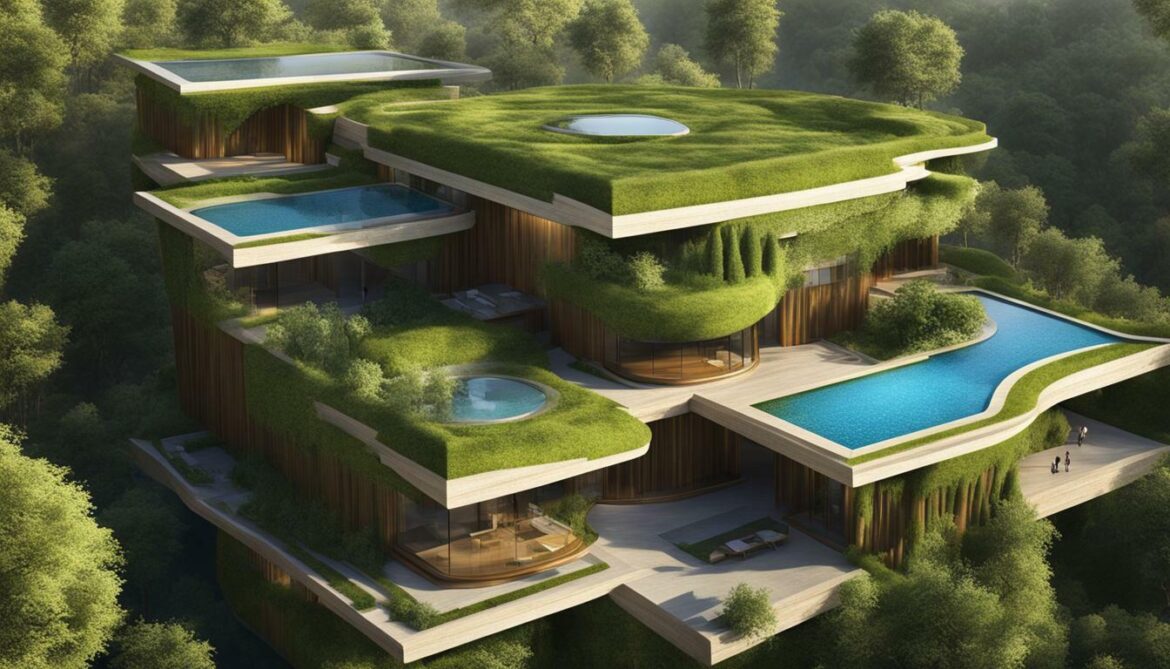
| Benefits of Green Building Design in Iran |
Examples of Green Building Projects in Iran |
| 1. Reduced energy consumption and lower carbon dioxide emissions. |
– Termeh Office Building |
| 2. Improved indoor air quality and occupant comfort. |
– Mosha House |
| 3. Efficient use of water resources. |
– Kahrizak residential building |
| 4. Lower operating costs and long-term financial savings. |
– Tabiat Bridge |
| 5. Contribution to a greener and more sustainable future. |
– Sharifi Ha House |
“Green building design in Iran combines contemporary architectural practices with sustainable construction techniques, creating a harmonious blend of functionality, aesthetics, and environmental responsibility.” – Dr. Amirhossein Mohammadi, Architect
In conclusion, Iran’s green building design initiatives and sustainable construction projects demonstrate the country’s commitment to promoting eco-friendly practices and addressing environmental challenges. Through the integration of green building principles and the use of innovative design strategies, Iran is driving positive change in its construction industry and creating a more sustainable future.
Sustainable Construction Projects in Iran
Iran is home to several remarkable sustainable construction projects that showcase the country’s commitment to green building initiatives and the use of environmentally friendly materials. These projects not only prioritize energy efficiency but also incorporate innovative designs that harmonize with Iran’s natural landscape.
One such project is the Termeh Office Building, located in Tehran. Designed with a focus on passive solar design principles, the building maximizes natural light and ventilation while minimizing the need for artificial lighting and air conditioning. The architects utilized locally sourced materials, such as rammed earth walls and traditional woodwork, to create a sustainable and visually striking structure that pays homage to Iran’s architectural heritage.
Another noteworthy example is the Tabiat Bridge in Tehran, which seamlessly blends aesthetics with sustainability. This pedestrian bridge, spanning over a busy highway, features green spaces, leisure areas, and panoramic views of the city. Constructed with recycled materials and equipped with solar panels, the bridge represents Iran’s commitment to integrating green technologies into urban infrastructure.
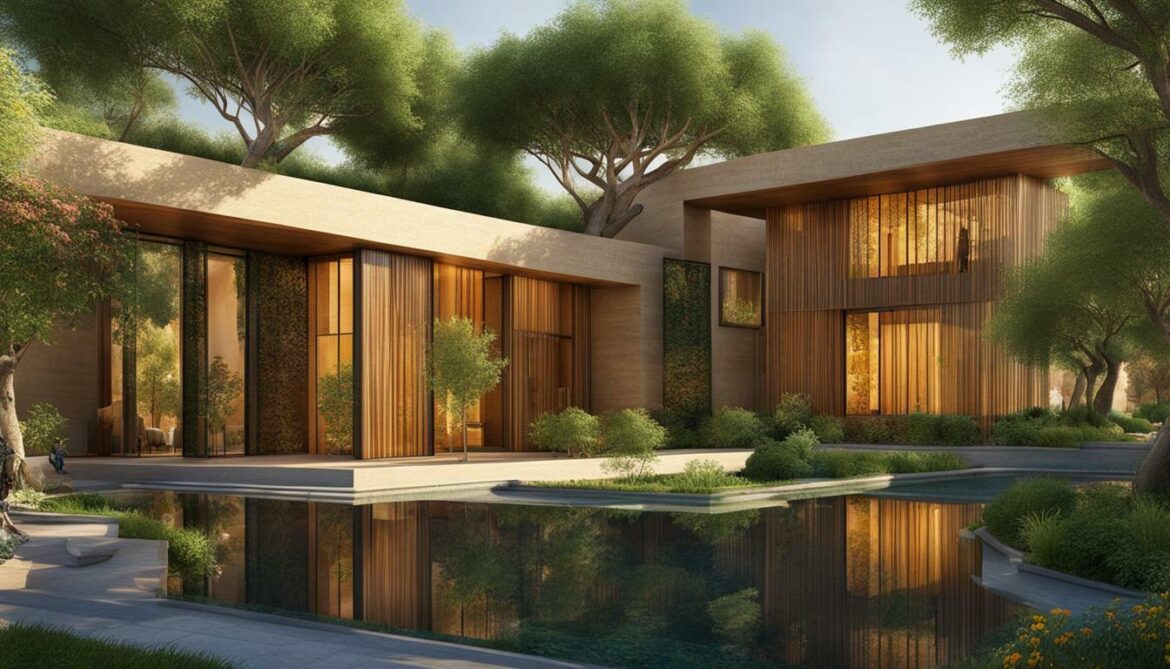
The Mosha House, located in Iran’s northern Gilan province, embodies both sustainable design and social responsibility. Built using locally sourced and recyclable materials, such as bamboo and mud bricks, this low-cost residential building provides affordable housing solutions while minimizing its ecological footprint.
Notable sustainable construction projects in Iran:
- Kahrizak residential building – Constructed with Earthbag technology, this multi-story building combines modern design elements with traditional and sustainable materials.
- Sharifi Ha House – This rotating house in Tehran utilizes smart design features, including movable rooms, to optimize energy efficiency and adapt to changing weather conditions.
These projects, along with others, serve as exemplars of Iran’s ambitious green building initiatives. By incorporating sustainable practices and utilizing environmentally friendly materials, Iran is paving the way towards a more eco-friendly future.
Table: Sustainable Construction Projects in Iran
| Project |
Location |
Key Features |
| Termeh Office Building |
Tehran |
Passive solar design, local materials |
| Tabiat Bridge |
Tehran |
Recycled materials, solar panels |
| Mosha House |
Gilan |
Locally sourced, recyclable materials |
| Kahrizak residential building |
Tehran |
Earthbag technology, sustainable materials |
| Sharifi Ha House |
Tehran |
Smart design, movable rooms |
Energy Efficiency Efforts in Iran
Iran is actively working towards sustainable development by placing a strong emphasis on energy efficiency in buildings and pursuing green building certifications. The country ranks among the top 10 emitters of carbon dioxide and expends a significant portion of its GDP on energy subsidies. To address these challenges, Iran has undertaken various efforts to improve energy efficiency and reduce its carbon footprint.
Collaboration between the UNDP, the Global Environment Facility, and the Vice-Presidency for Science and Technology has resulted in a project focused on improving national energy efficiency. As part of this initiative, pilot projects targeting government buildings have been implemented, leading to substantial savings in electricity and natural gas consumption. Energy audits have been conducted to identify areas for improvement, and energy-saving solutions have been implemented to significantly reduce energy consumption.
One of the key aspects of these energy efficiency efforts is the use of online platforms to create awareness and educate the public about sustainable construction practices. These platforms provide valuable information on energy-efficient technologies, green building materials, and best practices for reducing energy consumption. By increasing awareness and providing access to resources, Iran aims to empower individuals and organizations to make informed choices and contribute to the overall sustainability of the built environment.
Iran’s commitment to sustainable development is also reflected in its contemporary architecture. With the lifting of economic sanctions, the country has witnessed a boom in modern architectural design. Notable examples include the Termeh Office Building, Mosha House, Kahrizak residential building, Tabiat Bridge, and Sharifi Ha House. These buildings showcase a fusion of modern design principles and sustainable construction practices, creating environmentally friendly spaces that blend seamlessly with the surrounding landscape.

Incorporating traditional elements of vernacular architecture is another aspect that sets Iranian architects apart. By drawing inspiration from their rich historical and cultural heritage, architects are able to respect Iran’s past while embracing the future. This integration of traditional and contemporary design elements not only adds aesthetic value but also ensures a sustainable and harmonious relationship between the built environment and its surroundings.
Overall, Iran’s energy efficiency efforts, pursuit of green building certifications, and focus on sustainable construction practices are positioning the country for a greener and more energy-efficient future. By prioritizing energy efficiency and implementing innovative solutions, Iran is taking significant steps towards reducing its carbon footprint and creating a sustainable built environment.
Government Initiatives and Pilot Projects
The Iranian government has undertaken various initiatives and pilot projects aimed at improving energy efficiency in government buildings, resulting in substantial savings and increased awareness about sustainable construction practices. Through energy audits and the implementation of energy-saving solutions, significant reductions in electricity and natural gas consumption have been achieved.
One successful pilot project is the renovation of the Ministry of Energy building in Tehran. By installing energy-efficient lighting systems, improving insulation, and optimizing HVAC systems, the ministry was able to reduce its energy consumption by 30%. This project not only resulted in substantial savings but also served as a demonstration of sustainable construction practices to other government agencies.
Energy Audit and Awareness Platform
In addition to physical renovations, the Iranian government has also launched an online platform to promote energy efficiency and raise awareness about sustainable construction. The Energy Audit and Awareness Platform provides information on best practices for energy conservation, case studies of successful projects, and educational resources for architects, engineers, and contractors.
Collaboration for Sustainable Development
The Vice-Presidency for Science and Technology, in collaboration with the United Nations Development Programme (UNDP) and the Global Environment Facility (GEF), is spearheading a project to enhance national energy efficiency. This project aims to establish a comprehensive framework for sustainable construction and energy management in Iran, with a focus on green building certification and the adoption of renewable energy sources.
| Government Initiatives and Pilot Projects |
Key Achievements |
| Renovation of Ministry of Energy building |
30% reduction in energy consumption |
| Energy Audit and Awareness Platform |
Online resources for promoting energy efficiency |
| Collaboration with UNDP and GEF |
Framework for sustainable construction and energy management |
These initiatives and pilot projects not only contribute to a greener and more energy-efficient future but also serve as a model for private sector construction and development in Iran. By prioritizing sustainable construction practices and energy efficiency, Iran is taking a proactive approach to address its energy consumption and carbon emissions, positioning itself as a leader in sustainable development.
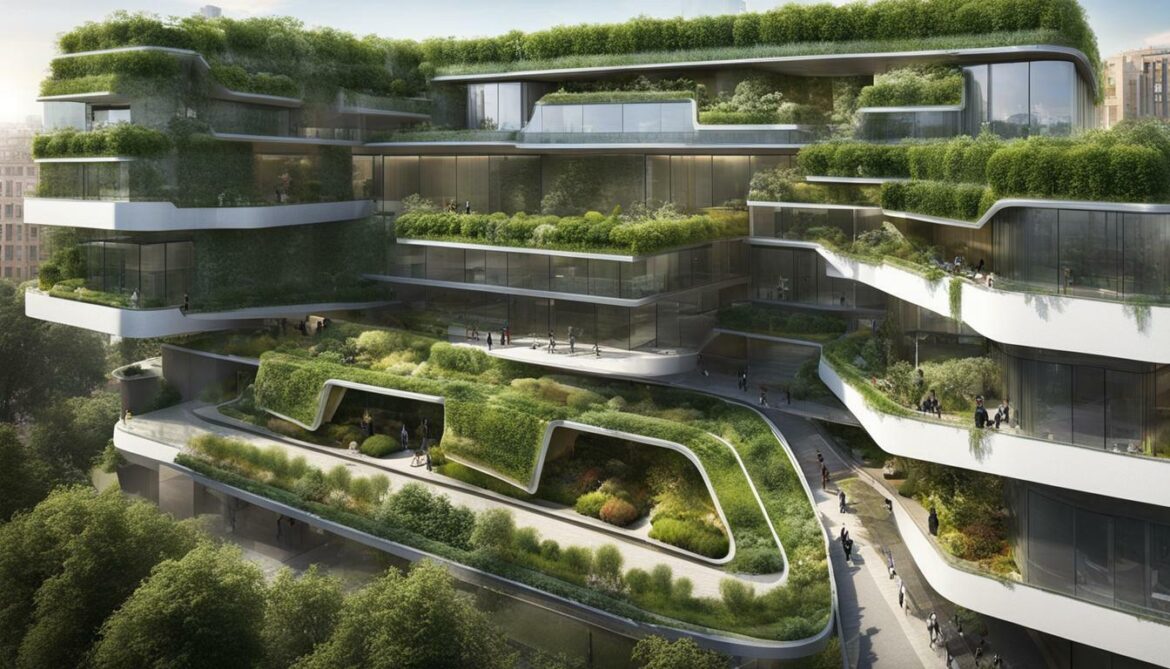
Iran is experiencing a flourishing period of contemporary architecture, where modern design principles are combined with sustainable construction practices to create environmentally friendly buildings that blend harmoniously with the country’s cultural heritage. Notable examples of this innovative approach can be seen in the Termeh Office Building, Mosha House, Kahrizak residential building, Tabiat Bridge, and Sharifi Ha House.
The Termeh Office Building, located in Tehran, showcases a striking blend of traditional Persian elements and modern sustainable design. Its unique facade features an intricate lattice work that not only adds aesthetic appeal but also provides shade, reducing the need for artificial cooling. The building also incorporates energy-efficient technologies, such as solar panels and rainwater harvesting systems, to minimize its environmental impact.
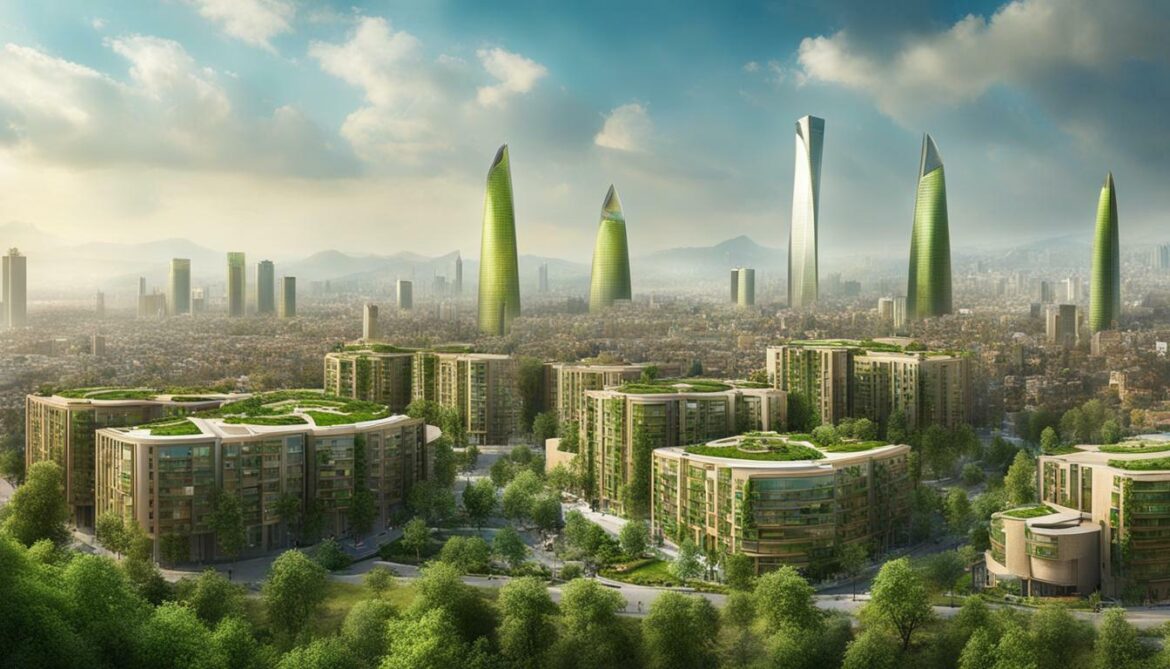
“Iran is experiencing a flourishing period of contemporary architecture, where modern design principles are combined with sustainable construction practices to create environmentally friendly buildings that blend harmoniously with the country’s cultural heritage.”
Another remarkable project, the Mosha House, is a prime example of how sustainability and aesthetic beauty can coexist. Located in Tehran’s Darband neighborhood, this residential building features a green roof adorned with trees, providing natural insulation and reducing energy consumption. The use of eco-friendly materials and efficient insulation systems further contribute to its environmental friendliness.
In addition to these architectural marvels, the Tabiat Bridge and Sharifi Ha House demonstrate Iran’s commitment to blending contemporary design with traditional elements. The Tabiat Bridge, located in Tehran’s Abbasabad Lands Park, is a pedestrian bridge that provides a scenic pathway while incorporating sustainable features such as natural ventilation systems and energy-efficient lighting. The Sharifi Ha House, on the other hand, showcases a unique rotating room concept, allowing residents to adapt to different seasons and optimize energy usage.
By embracing sustainable construction practices and incorporating traditional elements, Iran’s contemporary architecture is not only creating visually stunning buildings but also contributing to a greener and more energy-efficient future. These projects serve as a testament to the country’s dedication to preserving its cultural heritage while embracing modern advancements.
Iran’s Green Future
The ongoing green building initiatives and innovative architectural projects in Iran pave the way for a more sustainable and energy-efficient future, driving the country towards a greener tomorrow. Iran is making significant efforts to address its high energy consumption and carbon dioxide emissions, ranking among the top 10 emitters globally. To combat this, the country is investing in sustainable development and green building certifications to improve energy efficiency in buildings.
Collaborative efforts between the UNDP, the Global Environment Facility, and the Vice-Presidency for Science and Technology are underway to enhance national energy efficiency. Pilot projects targeting government buildings have already yielded positive results, showcasing significant savings in electricity and natural gas consumption. These projects include comprehensive energy audits, implementation of energy-saving solutions, and the use of online platforms to raise awareness and educate the public about sustainable construction practices.
Iran is also experiencing a renaissance in contemporary architecture, fueled by the lifting of economic sanctions. Architects are incorporating modern design principles while embracing sustainable construction practices to create environmentally friendly buildings. Notable examples include the Termeh Office Building, Mosha House, Kahrizak residential building, Tabiat Bridge, and Sharifi Ha House. These projects combine cutting-edge design with the incorporation of traditional elements of vernacular architecture, paying homage to Iran’s rich history and cultural heritage.
Overall, Iran’s commitment to sustainable development and green building initiatives sets the stage for a future that is greener, more energy-efficient, and environmentally conscious. By incorporating innovative design, energy-efficient technologies, and sustainable materials, Iran is taking significant strides towards creating a more sustainable built environment.
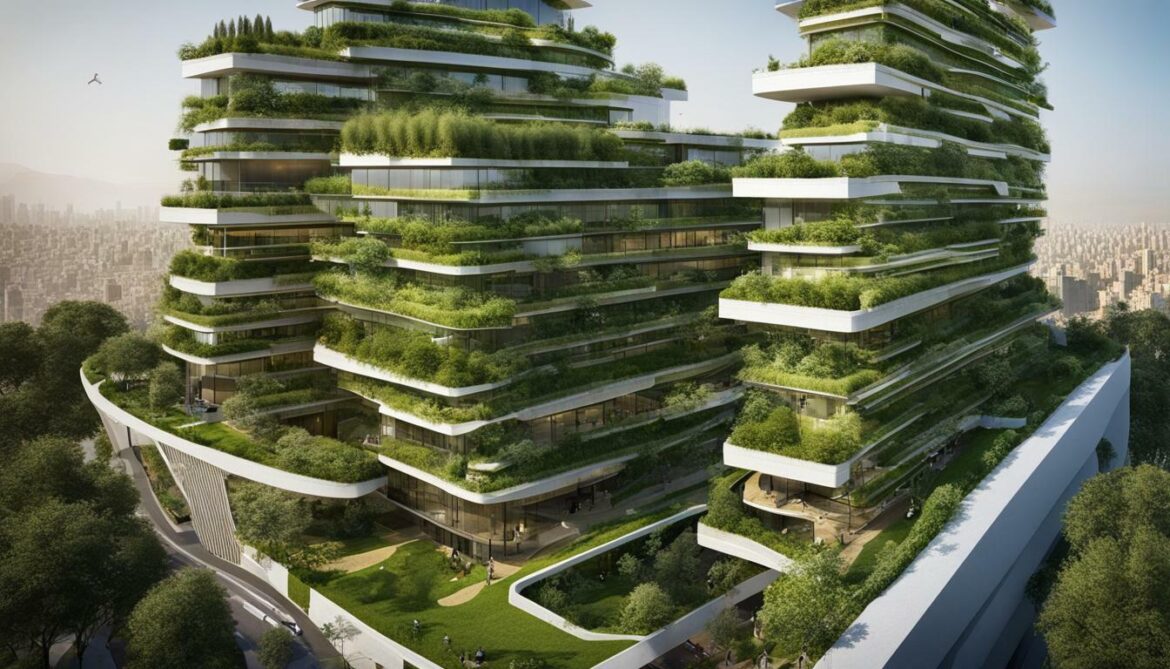
| Notable Green Buildings in Iran |
Location |
| Termeh Office Building |
Tehran |
| Mosha House |
Isfahan |
| Kahrizak Residential Building |
Tehran |
| Tabiat Bridge |
Tehran |
| Sharifi Ha House |
Tehran |
Conclusion
Iran’s commitment to sustainable construction, energy efficiency, and green building initiatives is not only transforming its architectural landscape but also contributing to a greener and more environmentally conscious future.
As one of the top 10 emitters of carbon dioxide, Iran recognizes the need to address its high energy consumption and carbon emissions. The country is taking significant steps to improve energy efficiency in buildings, partnering with organizations such as the UNDP, the Global Environment Facility, and the Vice-Presidency for Science and Technology to enhance national energy efficiency. This collaboration focuses on implementing energy audits, introducing energy-saving solutions, and raising awareness through online platforms, all aimed at reducing electricity and natural gas consumption.
The efforts to improve energy efficiency are particularly evident in pilot projects targeting government buildings, where substantial savings have been achieved. By incorporating energy-saving measures and adopting eco-friendly designs, these projects have proven successful in reducing energy consumption and promoting sustainability. Such initiatives not only benefit the economy but also contribute to a cleaner and healthier environment.
Furthermore, Iran’s architectural landscape is experiencing a renaissance following the lifting of economic sanctions. Contemporary buildings, such as the Termeh Office Building, Mosha House, Kahrizak residential building, Tabiat Bridge, and Sharifi Ha House, showcase a harmonious blend of modern design principles and sustainable construction practices. Architects in Iran are also embracing traditional elements of vernacular architecture, paying homage to the country’s rich history and cultural heritage.
Overall, Iran’s commitment to sustainable construction and green building initiatives is propelling the nation towards a greener and more energy-efficient future. Through the implementation of energy-saving strategies, the integration of eco-friendly designs, and the preservation of cultural heritage, Iran is setting an example for other nations as it strives to create a sustainable and environmentally conscious society.
FAQ
What is Iran doing to improve energy efficiency in buildings?
Iran is collaborating with organizations such as the UNDP, the Global Environment Facility, and the Vice-Presidency for Science and Technology on a project to improve national energy efficiency. Pilot projects targeting government buildings have resulted in significant savings in electricity and natural gas consumption.
How are energy audits and energy-saving solutions being implemented in Iran?
Energy audits are conducted in buildings to identify areas for improvement in energy efficiency. Energy-saving solutions, such as the use of energy-efficient appliances and insulation materials, are then implemented to reduce energy consumption.
What is the role of online platforms in promoting energy efficiency in Iran?
Online platforms are used to raise awareness and educate the public about sustainable construction practices in Iran. These platforms provide information on energy-saving techniques, green building certifications, and the benefits of energy efficiency.
How are traditional elements incorporated into contemporary architecture in Iran?
Iranian architects are integrating traditional elements of vernacular architecture into their contemporary designs to respect the country’s history and culture. This includes the use of traditional materials, architectural styles, and design motifs.
What are some notable examples of green buildings in Iran?
Some notable examples of green buildings in Iran include the Termeh Office Building, Mosha House, Kahrizak residential building, Tabiat Bridge, and Sharifi Ha House. These buildings showcase sustainable construction practices and energy-efficient design.
How do green building certifications contribute to sustainability in Iran?
Obtaining green building certifications ensures that buildings in Iran meet specific sustainability criteria. This includes the use of renewable energy sources, efficient water and energy systems, and environmentally friendly materials. Green building certifications promote sustainable development and reduce the environmental impact of buildings.
How do Iran’s efforts in sustainable construction contribute to a greener future?
Iran’s initiatives and architectural projects in sustainable construction and energy efficiency contribute to a greener and more energy-efficient future. By reducing energy consumption and carbon dioxide emissions, these efforts help mitigate environmental damage and promote a sustainable lifestyle.
Source Links






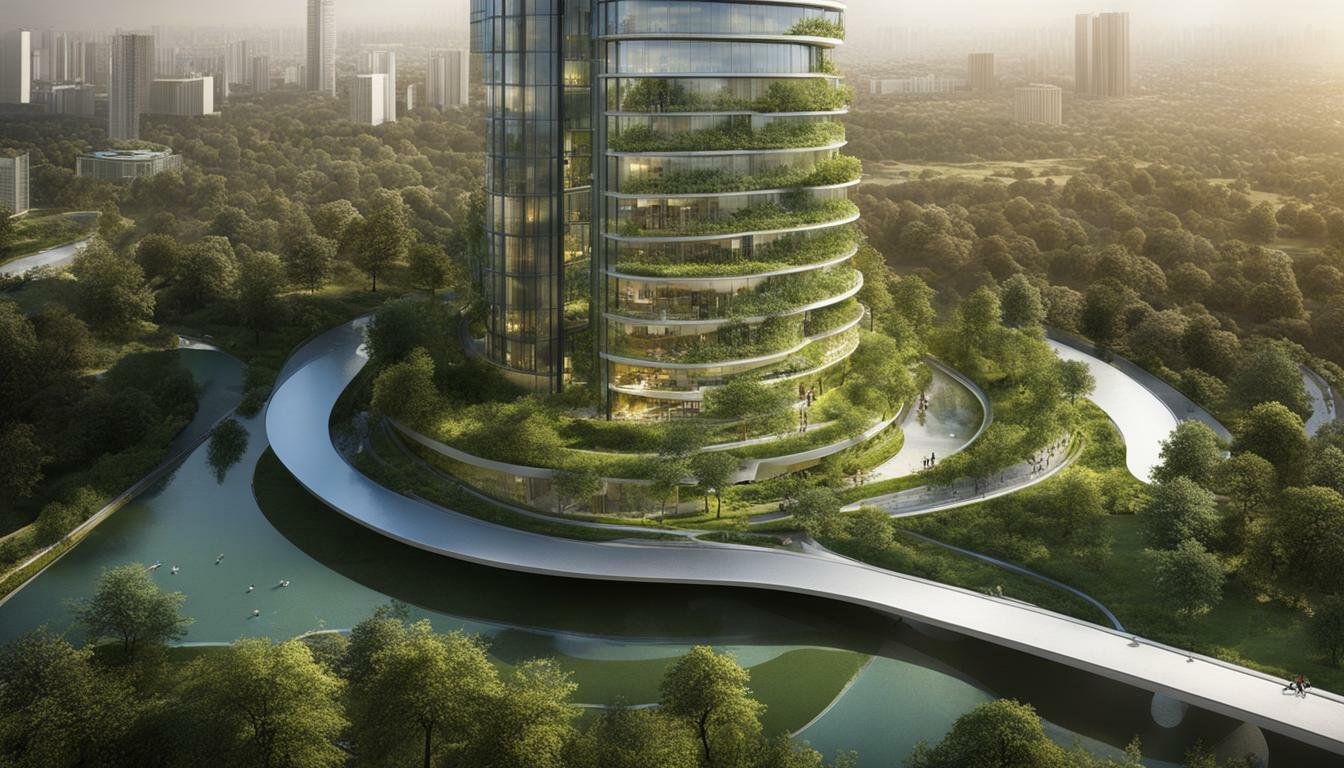

















Post comments (0)